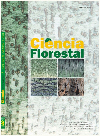
|
Ciência Florestal
Centro de Pesquisas Florestais - CEPEF, Departamento de Ciências Florestais - DCFL, Programa de Pós Graduação em Engenharia Florestal - PPGEF
ISSN: 0103-9954
EISSN: 0103-9954
Vol. 23, No. 1, 2013, pp. 139-151
|
 Bioline Code: cf13013
Bioline Code: cf13013
Full paper language: English
Document type: Research Article
Document available free of charge
|
|
|
Ciência Florestal, Vol. 23, No. 1, 2013, pp. 139-151
| en |
SELECTION OF SPECIES from natural forest AND INDICATION OF PLANTING DENSITY for RECLAMATION OF DEGRADED AREAS IN THE AMAZON FOREST
Salomão, Rafael Paiva; Santana, Antônio Cordeiro & Júnior, Sílvio Brienza
Abstract
The identification of species influencing the occurrence of other associated species is of fundamental
importance for the success of forest restoration of degraded areas. The objective of this work is to present
a phytosociological and socioeconomic index (IFSE), obtained by techniques of factor analysis, modeling
six quantitative variables (abundance, frequency, dominance, biomass, the commercial value of timber and
amount of non-timber forest products) and equal number of qualitative variables, whose dummy variable
is equal to one, assumed value for those species whose higher earnings amounted to 50 % of the total
for each quantitative variables analyzed. Sampling of the dense rain forest (407 ha) was composed by
80 plots of 0.25 ha (4.91 % of sampling intensity) and all individuals with diameter at 1.30 m above
the ground (DBH) ≥ 10 cm were identified and measured. It was recorded 10,105 individuals, including
493 species covering 58 families. The species were ranked by the index proposed in three categories of
priority phytosociological and socioeconomic status (high, medium and low). The appropriateness of factor analysis was determined by tests of Bartlett and KMO. The Bartlett's test evaluated the overall significance
of the correlation matrix and indicated that correlations were significant at 1 % probability. The KMO test
showed that the variables were correlated and the model of variance showed a very good level of fitness to
the data. These results endorsed the use of factor analysis to extract factors and estimate the factor scores.
The results were statistically validated for construction of the index IFSE and 25 species were selected as
the priority ones (key species). And also, it was recomended the planting density for these forest species for
restoration of degraded areas in Amazonia.
Keywords
selection of tree species; multivariate analysis; forest restoration; key species
|
| |
| pt |
SELEÇÃO DE ESPÉCIES DA FLORESTA OMBRÓFILA DENSA E INDICAÇÃO DA DENSIDADE DE PLANTIO NA RESTAURAÇÃO FLORESTAL DE ÁREAS DEGRADADAS NA AMAZÔNIA
Salomão, Rafael Paiva; Santana, Antônio Cordeiro & Júnior, Sílvio Brienza
Resumo
A identificação de espécies-chave que influenciam a ocorrência das demais espécies associadas é de
fundamental importância para o sucesso da restauração florestal em áreas degradadas. Objetivou-se neste
trabalho apresentar um índice fitossociológico e socioeconômico (IFSE), obtido por técnicas de análise
fatorial, cujo modelo envolveu seis variáveis quantitativas (abundância, frequência, dominância, biomassa,
valor comercial da madeira e quantidade de produtos florestais não madeireiros) e igual número de variáveis
qualitativas, cuja variável dummy assumiu valor igual a 1 para aquelas espécies cujos maiores valores
acumulados equivaleram a 50 % do total para cada uma das variáveis quantitativas analisadas. A amostra
para o inventário florestal em 407 ha de floresta ombrófila densa foi composta por 80 parcelas de 0,25 ha
(4,91 % de intensidade amostral) onde todos os indivíduos com diâmetro a 1,30 m do solo (DAP) ≥ 10
cm foram identificados e mensurados. Foram registrados 10.105 indivíduos, distribuídos em 493 espécies,
abrangendo 58 famílias. As espécies foram ranqueadas através do índice proposto em três categorias de
prioridade fitossociológica e socioeconômica (alta, média e baixa). A adequação da análise fatorial foi
determinada pelos testes Bartlett e KMO. O teste de Bartlett avaliou a significância geral da matriz de
correlação indicando que as correlações, em geral, são significantes ao nível de 1 % de probabilidade. O
teste KMO, indicou que as variáveis estão correlacionadas e o modelo fatorial apresentou um nível muito
bom de adequação aos dados. Estes resultados respaldaram o emprego da análise fatorial para a extração de
fatores e a estimação dos escores fatoriais. Os resultados foram estatisticamente validados para a construção
do IFSE e, 25 espécies foram selecionadas como prioritárias (espécies-chave). Recomendou-se a densidade
de plantio para essas espécies florestais na recuperação de áreas degradadas na Amazônia.
Palavras-chave
seleção de espécies arbóreas; análise multivariada; restauração florestal; espécie-chave
|
| |
© Copyright 2013 - Ciência Florestal
Alternative site location: http://cascavel.ufsm.br/revistas/ojs-2.2.2/index.php/cienciaflorestal/index
|
|
